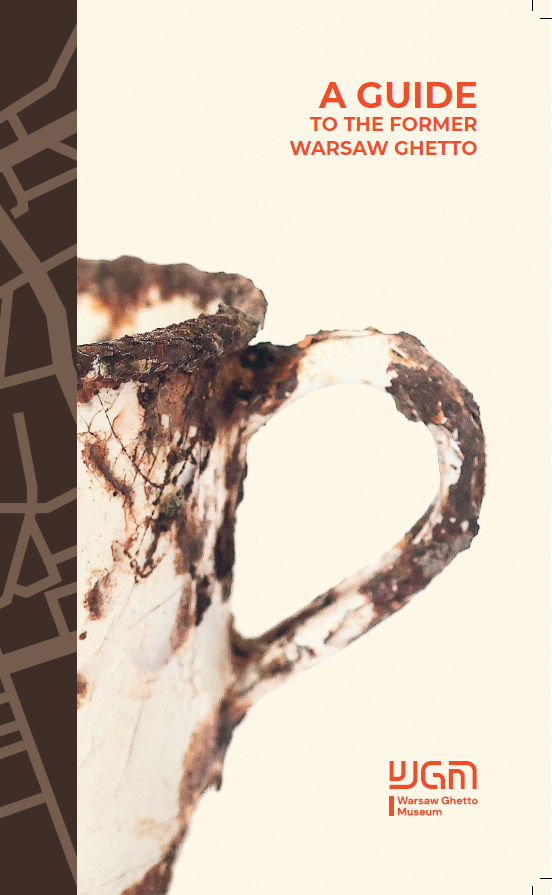“A guide to the Former Warsaw Ghetto” by Masza Makarowa
“A Guide to the Former Warsaw Ghetto” is Warsaw Ghetto Museum’s newsest publication. Now available in out on-line store!
In the “Guide to the Former Warsaw Ghetto”, you will find information on 60 of the most important sites in the former ghetto – preserved fragments of the walls of the enclosed district, landmarks and remnants that can still be found in this part of Warsaw, memorials and monuments from various periods.
“How does one visit a place that no longer exists? Is it possible to write a guide to a part of Warsaw that has been wiped out, along with the streets, the buildings, the prayer houses, and, above all, the people who lived there? Can the story of whatis absent be told by memorials?” – wonders the author, Masza Makarowa.
The guide suggests sightseeing routes marked on specially prepared maps. The stories about individual sites are accompanied by archival photographs, among others from the collections of the Warsaw Ghetto Museum, and photographs of contemporary Warsaw. The publication also includes a list of all the memorials in the former ghetto.

The word “ghetto” wasn’t always synonymous with death and destruction. Since the sixteenth century, in Italy and other parts of Europe,it has referred to neighbourhoods where Jews lived voluntarily or as a result of discriminatory laws. This allowed them to keep their religious and cultural identity intact. The first use of the word probably dates back to 1516 in Venice. In October 1940, the Germans created a ghetto in the northern part of Warsaw, including in part of Muranów. The name of this neighbourhood comes from the Murano palace built there at the end of the seventeenth century by Simone Giuseppe Belotti, who hailed from Venice. This is how history came full circle in Warsaw, although instead of “ghetto”, the Germans preferred the euphemism “Jewish residential quarter”.
The Warsaw ghetto was the largest ghetto in occupied Europe. At the beginning of 1941 it covered an area of around 307 hectares. The closed quarter was surrounded by a wall eighteen kilometres long. Initially, some 390,000 Jews lived within this enclosure, but just a few months later, this number swelled to around 450,000, as a result of a massive influx of Jewish refugees and deportees from other towns. Some of the Jews residing in Soviet-occupied eastern Poland in the autumn of 1939 were also moved to Warsaw ghetto in 1941 after the start of the German-Soviet war. The ghetto walls separated the Jews inside from the rest of Warsaw. They made it difficult to move around the city, since they often cut streets in half. They made life and suffering inside the ghetto invisible to witnesses on the Aryan side, but they also barred those living in the ghetto from accessing their city on the other side of the wall.
“I often look at the sky and conclude that the sky in the ghetto is just as beautiful and enchanting and no less pretty than the sky in Rome or elsewhere”, Abraham Lewin wrote in his journal in the Warsaw ghetto on 20 June 1942. “Our ghetto sky lacks one thing: a horizon. The ghetto is so small and surrounded by walls and ruins. There is no empty space for the eye to freely take in a larger field and see a broader expanse of sky with a horizon. We only see it as a prisoner does from his cell. This is very sad and depressing.”
The walls of the Warsaw ghetto were largely destroyed during the liquidation of the closed quarter, at the time of Warsaw Uprising, and after the war. Some fragments still survive in a number of locations. They are, for the most part, the walls of pre-war buildings or the walls of the Jewish cemetery, which became the boundary between the ghetto and what was known as the Aryan side; there are also the walls erected in the spring of 1940 by the Judenrat (Jewish Council) at the behest of the German occupation authorities. In 2008 memorials marking the ghetto boundaries were placed on some of these surviving walls. It was the first time that they were visibly marked in contemporary Warsaw. A list and map of these memorials has been included at the end of this guide.
The guide we have prepared will take you on a tour of the most important sites linked to the history of life and death in the Warsaw ghetto. If you are only in Warsaw for a short time, we have selected the most important sites you can visit in a couple of hours. If you have more time, you can discover this part of Warsaw by following our story about the small and large ghetto, discovering the history of places you pass on your regular journeys through the city. Sometimes all it takes is looking at the back of a new building, entering a gate, or bending down to read an inscription on the pavement to see the hidden history of the ghetto against the backdrop of contemporary Warsaw. We’ll tell you where to look.
Excerpt from the introduction of the book “A Guide to the Former Warsaw Ghetto”

